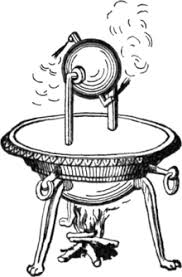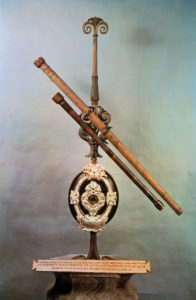
“[We] cannot find out the use of steam engines, until comes steam-engine-time. ” Charles Fort
Charles Fort was an extraordinary thinker and a witty if challenging writer. Born into the heart of the steam-driven industrial revolution, He was nonplussed to learn about the Aeolipile, an ancient Roman steam engine. It was a very simple device and researchers aren’t certain if it was an entertaining party trick or had some small practical use. We do know that its impact on this historical period is zero. It didn’t capture the imagination of the time or generate new ideas and new technologies. It was intellectually inert.
researchers aren’t certain if it was an entertaining party trick or had some small practical use. We do know that its impact on this historical period is zero. It didn’t capture the imagination of the time or generate new ideas and new technologies. It was intellectually inert.
What then makes a technological breakthrough roar into life seemingly from nowhere? Why do paradigm shifts sometimes appear startlingly fast?
“Steam engine time” may sound too techno-mystical to be an idea of practical use but I think the meaning is straightforward. Steam engine time (or gunpowder time or antibiotic time) is an EMERGENT effect of the laying down sufficient essential substrate to make the idea fertile. That substrate collects slowly and incrementally. It consists of underlying 1. technological and 2. intellectual readiness.
- The sort of hardware needed to express the idea physically must be “off the shelf” accessible. Not like Superstore accessible but in the general world of the moment and probably serving completely unrelated purposes at present. If you have to invent a bunch of other things to compile and test your idea, it isn’t time yet.
- There must be a sort of slowly heating or charging excitement growing in the community of innovators and thinkers. They may keep their thoughts to themselves but related ideas are percolating and making connections throughout the surrounding world. The questions are crystallizing and there is a growing sense of urgency. Competition plays a part too. Pride and fear add to the pressure. This process speeds up when more people are engaging with the issue.
If you’ve read my stuff on Darwin and Wallace you know of their representative competition but the IDEA of evolution was on a low boil everywhere in their cultural moment. The substrate was laid and the moment was fertile. Their theories (and others) could only emerge in a powerful way that shaped the future from this state of readiness. A breakthrough theory coming before the substrate is ripe and ready is roundly ignored.
Feuding Dutchmen, and Telescope Time
With the Renaissance came a new freedom of thought and hunger for knowledge. Ptolemaic knowledge of astronomy was rediscovered and published along with mythology, astrology, and philosophy. Our place in the universe was one of the ideas beginning to bubble in many minds. Technology and craftsmanship rose from the old, rediscovered knowledge and quickly had a practical impact. It was inevitable that as glassmaking and lens-grinding techniques improved in the late 1500s, someone would hold up two lenses and observe what they could do.
The first patent application for a telescope came from Dutch eyeglass maker Hans Lippershey. In 1608, Lippershey claimed he’d invented a device that could magnify objects three times. His telescope had a concave eyepiece aligned with an objective convex lens. Another eyeglass maker, Zacharias Jansen, claimed Lippershey had stolen the idea from him. Jansen and Lippershey lived in the same town and both worked on making optical instruments.
We have no evidence that Lippershey did not develop his telescope independently therefore, he gets the credit for the telescope, because of the patent application, while Jansen is credited with inventing the compound microscope. Both appear somehow to have been a part of the development of both instruments.
This is an extraordinary impact on science and the future from one little Dutch town and two very competitive residents. Our exploration of the very big and far and the very small and close comes to us courtesy of this jealous, grumpy lens grinding soap opera.
Selenography (Moon Pictures)
Galileo Galilei, an Italian polymath was appointed a professor of mathematics in Padua in 1592. He remained there for 18 years and over this period, his house became a military academy. He taught students the art of warfare and gave lectures in geometry, technical drawing, and fortress construction. His nature was bold and challenging, in his scientific education he took nothing on faith and subjected all accepted truths to skeptical scrutiny and experiment. His perceived arrogance attracted negative attention. He was committed to honesty in science from the understanding that all scientists depend on each other to keep the common well water clean.
The Geocentric (earth-centered) theory of Ptolemy was the accepted foundation of both Astronomy and Theology. The Heliocentric (sun-centered) Copernican theory circulated as a widely scorned crackpot belief. Galileo thought it ridiculous but was struck by the earnest intensity of Copernican believers. He knew from firsthand experience that they were paying a social price for their advocacy and concluded they must have been deeply affected by the available evidence to take their stand. He would learn eventually how high that cost could be.
In 1609, Galileo heard about “Dutch perspective glasses” and immediately designed one of his own — without ever having seen one. He made some big improvements: His device could magnify objects 20 times. He composed his telescopes out of odds and ends of random-seeming objects commonplace in his world. The thimblerig process is enjoyably described here by an Italian website devoted to Galileo:
“How he went about this is divulged by a shopping list written on the back of a letter which Ottavio Branzini sent him from Venice. At the top of the list were items from Venice, such as Malvasia wine and clothes for his domestic partner Marina. These items are followed by a very strange list of objects: artillery balls, two tin organ pipes, Tripoli powder, iron bowls, Greek pitch and felt.
Galilei had assembled the utensils which he deemed necessary for the construction of a telescope. Artillery balls, for example, are almost perfectly rounded. Spectacle makers used them to grind glass lenses. Galilei also planned to use Greek pitch and Tripoli powder for the grinding process. The felt was required for the subsequent polishing, and the organ pipes could be used as tubes.
Using various materials, such as German spectacle lenses, mirror glass, and rock crystal, and with the help of various technical processes – he had already acquired his own grinding machine for lenses in late 1609 – Galilei designed an excellent telescope. In January 1610, he spotted the first three of what would later become four Jupiter moons. He drew the moon in a way that no one had ever seen it before: with mountain ranges and valleys. He hurriedly published his explosive findings. By 12 March 1610, 550 printed copies of his work Sidereus Nuncius (Starry Messenger) had been dispatched into the world. This treatise would make him famous throughout Europe.”
Nerdy obsession, anxious competition, and brilliant, seat-of-the-pants junkyard engineering “took us to the moon” for the first time. The whole process described here unfolds over 2 years but really those 2 years are situated within the moment of perfect ripeness for the ideas and skills behind the telescope which had coalesced over centuries to reach that sweet spot.
The final ingredients that activate the substrate are the people of various skills and personalities drawn instinctively to work on part of the question. Telescope time required quiet systematic craftspeople for the first step and a bold loud-talking genius for the second step. Humans gather around the question like ants mending a wall, preparing it; then we strike like lightning, as fast as we can, when the substrate is ready. We’ve seen it again and again. We sense the coming of something new and those with the passion crowd in like midwives to catch the baby.
Above – Two of Galileo’s early telescopes
Below – Galileo’s initial drawings from telescopic observation.
Afterthought
Direct observation of the solar system with a homemade, handheld device led Galileo to complete acceptance of the Copernican system he had once scorned. He had witnessed it with his own eyes. He forthrightly published his evidence and reasons, greatly aiding the advancement of science, but suffered permanent silencing and house arrest under the inquisition. He truly took one for the team but not before throwing the switch of a vast and permanent paradigm change. This scarcely describes the crushing intimidation, fear, and humiliation directed at him by the Inquisition. He was literally forced to recant on his knees before being allowed to live out his life under house arrest. Due to the power of the ripe and ready moment though, his message caught fire and burned the Ptolemaic model to ash. The church lost its “fig leaf” of scientific credibility and stood alone, validated only by its own assertions. The modern age had begun.
Take a moment to consider the simple purity of Galileo’s 3 step approach,
- Direct observation
- Critical evaluation
- Honest reporting
and how it can change the world.

